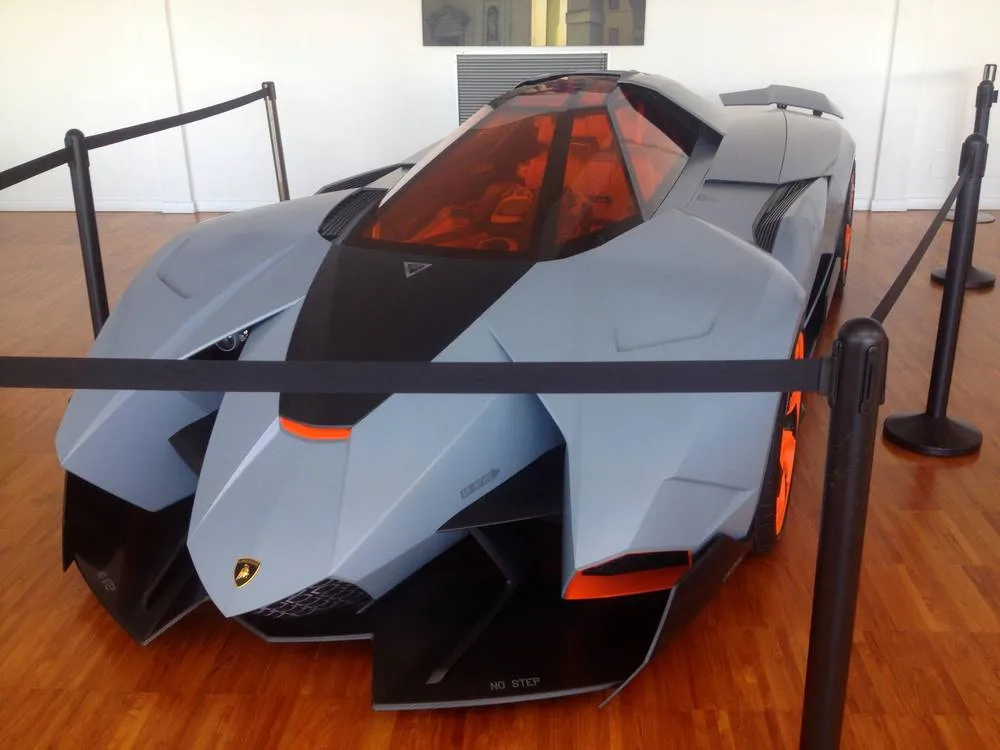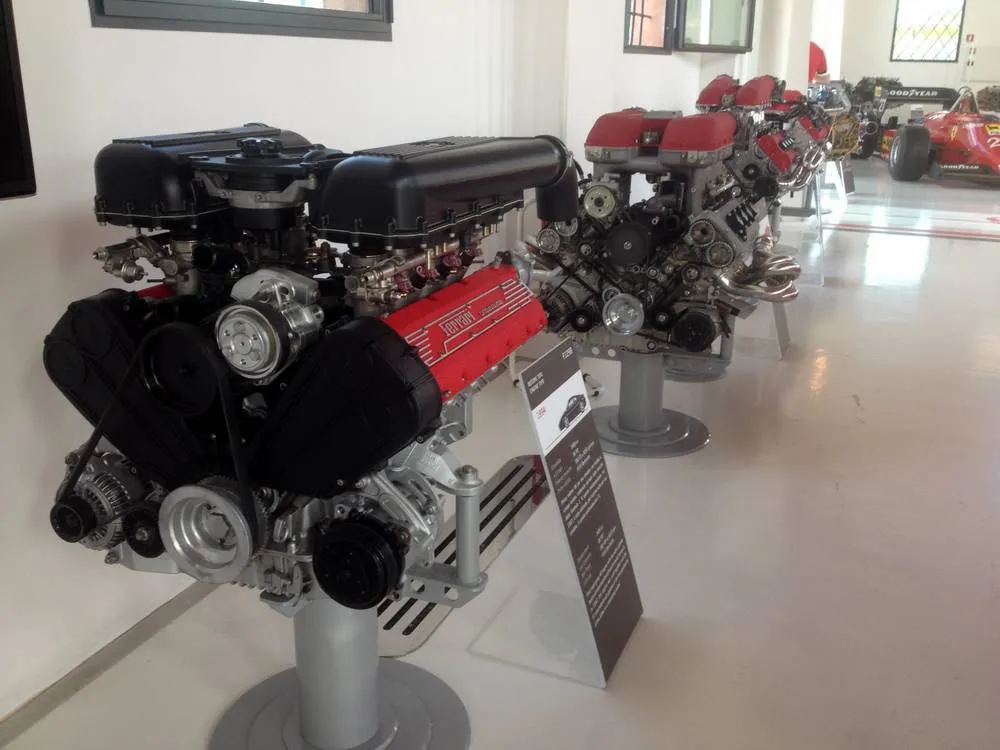While traveling across Europe, we took in three distinctive styles of cars and the museum dedicated to them each. Two are worthy, but there’s a clear winner in this blogger’s opinion. Which one? Go on, guess.
First, the Lamborghinis…
Officially called the Centre Eccellenze Lamborghini, the Lambo museum is best approached from Bologna.

Inaugurated in 2001, the Lamborghini museum showcases Italian craftsmanship and avant-garde technology. Beyond the two-story museum there’s also a factory tour, though no photos are allowed and you’ll need to make reservations in advance for them. Photos are OK in the museum, but don’t touch the cars.
Not pictured here is the souvenir store (AKA ‘the boutique’), which featured some obscenely priced branded items – the five-figure price tag for carbon fiber luggage bearing the iconic Lamborghini name took the cake. I can’t help but wonder what it says about a person when they need a car to do the talking for them…

There’s no obvious pace to start, and it’s more showroomy than anything else. You start on the first floor, which is more varied, though the classic Lambo look can be seen on them all. Good English signage.

The second floor holds several concept cars and a couple of extremely short run cars – one is unique, and another is one of only two in existence.

A more stripped-down looks at the framework of a Lambo.
The two floors can be perused in less than 20 minutes, and there’s no escaping the sky-high price tags even where none are displayed. There’s some of the company’s history, but not It is as you might expect – a classy / pretentious look at a classy / pretentious brand that sells classy / pretentious cars. Don’t be surprised to see some Lambos out front as well.
Name: Lamborghini Museum / Centre Eccellenze Lamborghini
Address: 40019 Sant’Agata Bolognese via Modena, 12, Sant’Agata Bolognese BO, Italy (GPS: 44.658933, 11.124923)
Directions: From Bologna, take bus 576 to Lamborghini Museum (only comes every 30-60 minutes). 3 € trip to an out-of-Bologna zone, pay driver if you don’t have tickets. (you’re halfway to Modena, the nearby town)
Hours:10am-noon and 2:30pm-5pm.
Admission: up to 12 years old is free, otherwise 13 € for the museum or 40 € for the museum and guided factory tour (reservations required)
Phone: +39 051 681 7611
Website: www.lamborghini.com/en/museum/overview/
Next up, the Ferrari museum…

Now that’s what I call a car! The Ferrari F40 is noted as a pure racing machine, while also being the only Ferrari the iconic Luciano Pavarotti ever bought.
Your mileage may vary (ha!), but even the decades-old cars have a futuristic look to them… Much closer to Modena than Bologna, the first thing that hits you is the opera playing throughout the facility – Ferrari met Pavarotti, and each piece goes with the artistic intent of the car… or something like that. Cars are put on stands while text and pictures are pushed off to walls to avoid being the center of attention.

From 2013, the LaFerrari electric car gets 963 horsepower and a top speed of 350 kilometers an hour.
Projections on walls seem out of place as they’re barely visible against a blank white wall. History has plenty of English and shows plenty of wins under their racing belts

It may not have today’s sleek look, but back in 1924, this Alfa Romeo RL Targa Florio could hit a top speed of 180 kilometers an hour. Enzo Ferrari won what the sign calls his ‘most prestigious victory’ in a car like this. It’s worth noting the majority of their cards are the correct color for a high-end brand: fiery, cherry red.

Once you’ve finished enjoying the 20 cars in the main hall, head to the other building for a museum of engines. Once the site of the humble workshop that was Alfredo Ferrari’s (Enzo’s father), what’s on display are plenty of classic and modern designs of both engines and cars.

A rather odd reconstruction of the old office.

Look for an engine from the 1950 375 F1 in a hydroplane, which set a world speed record of 242km/h.
Before leaving, stop by the cafe for a surprisingly cheap cup of coffee, but be aware a 33cl Corona will set you back 5 €.
For extra credit to this side of Bologna, open your wallet. 60 euros buys you 48-hour access to a shuttle bus and admission to several other sites, including the Luciano Pavarotti House, seven producers of traditional balsamic vinegar, Parmigiano Reggiano cheese, cured meat, and more. Learn more at ferraripavarottiland.it.
Name: Ferrari Museum (Museo Enzo Ferrari)
Address: Via Giuseppe Soli, 101, 41121 Modena MO, Italy (GPS: 44.652036, 10.936902)
Directions: From Modena, take bus 9 or 14 to the Ferrari Bivio Soli bus stop. From the bus stop, head about 100 meters northeast, then take a right onto Via Giuseppe Soli. Look left for the museum.
Hours: 9:30am-6pm Nov-March, until 7pm April-October.
Admission: 15 €
Phone: +39 059 439 7979
Website: http://www.museiferrari.com or museomodena.ferrari.com.
…but what the heck’s a Trabi?

The Trabant (also called Trabi) was ‘the East German car that could’. Could what? Everything, it seems. Even today, they have a cult following, which is sometimes called ‘eastologia’ (nostalgia for eastern Germany) – 20,000 people a year attend the International Trabant Festival in Zwickau, in what was formerly East Germany. Today and now, Trabants had room for family and could have been fixed by yourself.
After World War II ended, Soviet Union confiscated most everything as ‘reparations’. Engineers didn’t have steel, so they made Duroplast – Russian cotton that couldn’t be dyed and cardboard to be specific, compressed to 40 kg per square centimeter. “A car out of cardboard”, its deriders claimed, which was mostly true – but it was shown to be stable by having several people stand or sit on top.

The Communist powers-that-were deemed that only 12,000 cars would be made, which wasn’t nearly enough to supply the demand. While designed to be easy to fix, people hoarded spare parts to ensure their car would continue to run for as long as possible.
Ahead of Renault and Peugeot, they created the first hatchback car in Europe. Developed in secret, they went to address the Party to petition their new car be allowed for sale. Denied, VW made the Golf 1 in 1993 (which was a copy of the Trabant 603).
Many Trabants crossed during the fall of the wall in 1989, but the last Trabant off the line rolled into a museum. Structural characteristics of Duroplast proved it passed crash tests with flying colors, and they’re easily modified since they’re all very similar cars…
Not pictured here is an excellent 60-minute documentary that’s more informative than most of the exhibits, and shows some of cult following. If time is short, purchase the documentary in the gift shop instead.
It’s a worthwhile collection, tells the history well, and revels in the creativity / ingenuity of the Trabant’s engineers.

Head down the street about 80-100 meters to take part in a self-driving guided tour – featuring Trabants of course. See trabiworld.com for more details.
Name: Trabi Museum
Address: Zimmerstraße 14-15, 10969 Berlin, Germany (GPS: 52.507478, 13.388907)
Directions: Take Berlin’s excellent metro system to U Kochstrasse / Checkpoint Charlie on the U6 line. Walk north for about 100 meters towards Checkpoint Charlie, then look left for Zimmerstrasse. Walk another 100 meters and look left for the museum.
Hours: 10:00am-6:00pm everyday
Admission: 4 € – 50% off with Berlin card,
Phone: +49 30 30201030
Website: trabi-museum.com


